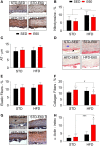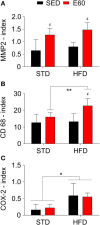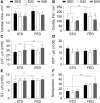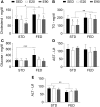High-Fat and Fat-Enriched Diets Impair the Benefits of Moderate Physical Training in the Aorta and the Heart in Rats
- PMID: 28573134
- PMCID: PMC5435813
- DOI: 10.3389/fnut.2017.00021
High-Fat and Fat-Enriched Diets Impair the Benefits of Moderate Physical Training in the Aorta and the Heart in Rats
Abstract
Aim: Millions of people die each year due to cardiovascular disease (CVD). A Western lifestyle not only fuses a significant intake of fat with physical inactivity and obesity but also promotes CVD. Recent evidence suggests that dietary fat intake impairs the benefits of physical training. We investigated whether aerobic training could reverse the adverse effects of a high-fat diet (HFD) on the aorta. Then, we explored whether this type of exercise could reverse the damage to the heart that is imposed by fat-enriched diet (FED).
Methods: Rats were randomly assigned to two experiments, which lasted 8 weeks each. First, rats swam for 60 min and were fed either a regular diet [standard diet (STD)] or an HFD. After aortic samples had been collected, the rats underwent a histopathological analysis for different biomarkers. Another experiment subjected rats that were fed either an STD or an FED to swimming for 20 or 90 min.
Results: The first experiment revealed that rats that were subjected to an HFD-endured increased oxidative damage in the aorta that exercises could not counteract. Together with increased cyclooxygenase 2 expression, an HFD in combination with physical training increased the number of macrophages. A reduction in collagen fibers with an increased number of positive α-actin cells and expression of matrix metalloproteinase-2 occurred concomitantly. Upon analyzing the second experiment, we found that physically training rats that were given an FED for 90 min/day decreased the cardiac adipose tissue density, although it did not protect the heart from fat-induced oxidative damage. Even though the physical training lowered cholesterol levels that were promoted by the FED, the levels were still higher than those in the animals that were given an STD. Feeding rats an FED impaired the swimming protocol's effects on lowering triglyceride concentration. Additionally, exercise was unable to reverse the fat-induced deregulation in hepatic antioxidant and lipid peroxidation activities.
Conclusion: Our findings reveal that an increased intake of fat undermines the potential benefits of physical exercise on the heart and the aorta.
Keywords: biochemistry; blood vessels; heart; obesity; swimming.
Figures






Similar articles
-
Protective effects of exercise on heart and aorta in high-fat diet-induced obese rats.Tissue Cell. 2019 Apr;57:57-65. doi: 10.1016/j.tice.2019.01.005. Epub 2019 Feb 14. Tissue Cell. 2019. PMID: 30947964
-
Effect of physical training on the adipose tissue of diet-induced obesity mice: interaction between reactive oxygen species and lipolysis.Horm Metab Res. 2013 Mar;45(3):190-6. doi: 10.1055/s-0032-1323740. Epub 2012 Sep 12. Horm Metab Res. 2013. PMID: 22972182
-
Effects of endurance training on autophagy and apoptotic signaling in visceral adipose tissue of prolonged high fat diet-fed rats.Eur J Nutr. 2018 Sep;57(6):2237-2247. doi: 10.1007/s00394-017-1500-5. Epub 2017 Jul 11. Eur J Nutr. 2018. PMID: 28699087
-
High-fat diet leads to adiposity and adipose tissue inflammation: the effect of whey protein supplementation and aerobic exercise training.Appl Physiol Nutr Metab. 2019 Mar;44(3):255-262. doi: 10.1139/apnm-2018-0307. Epub 2018 Aug 14. Appl Physiol Nutr Metab. 2019. PMID: 30107135
-
Impact of eight weeks endurance training on biochemical parameters and obesity-induced oxidative stress in high fat diet-fed rats.J Exerc Nutrition Biochem. 2016 Mar 31;20(1):29-35. doi: 10.20463/jenb.2016.03.20.1.5. J Exerc Nutrition Biochem. 2016. PMID: 27298810 Free PMC article.
Cited by
-
Exercise attenuates high-fat diet-induced PVAT dysfunction through improved inflammatory response and BMP4-regulated adipose tissue browning.Front Nutr. 2024 May 9;11:1393343. doi: 10.3389/fnut.2024.1393343. eCollection 2024. Front Nutr. 2024. PMID: 38784129 Free PMC article.
-
Resistance Exercise Training Mitigates Cardiac Remodeling Induced by a High-Fat Diet in Rodents: A Systematic Review.Arq Bras Cardiol. 2024 Apr;121(4):e20230490. doi: 10.36660/abc.20230490. Arq Bras Cardiol. 2024. PMID: 38695409 Free PMC article. English, Portuguese.
References
-
- Ni H, Xu J. Recent trends in heart failure-related mortality: United States, 2000–2014. NCHS Data Brief (2015) 231:1–8. - PubMed
LinkOut - more resources
Full Text Sources
Other Literature Sources
Research Materials

